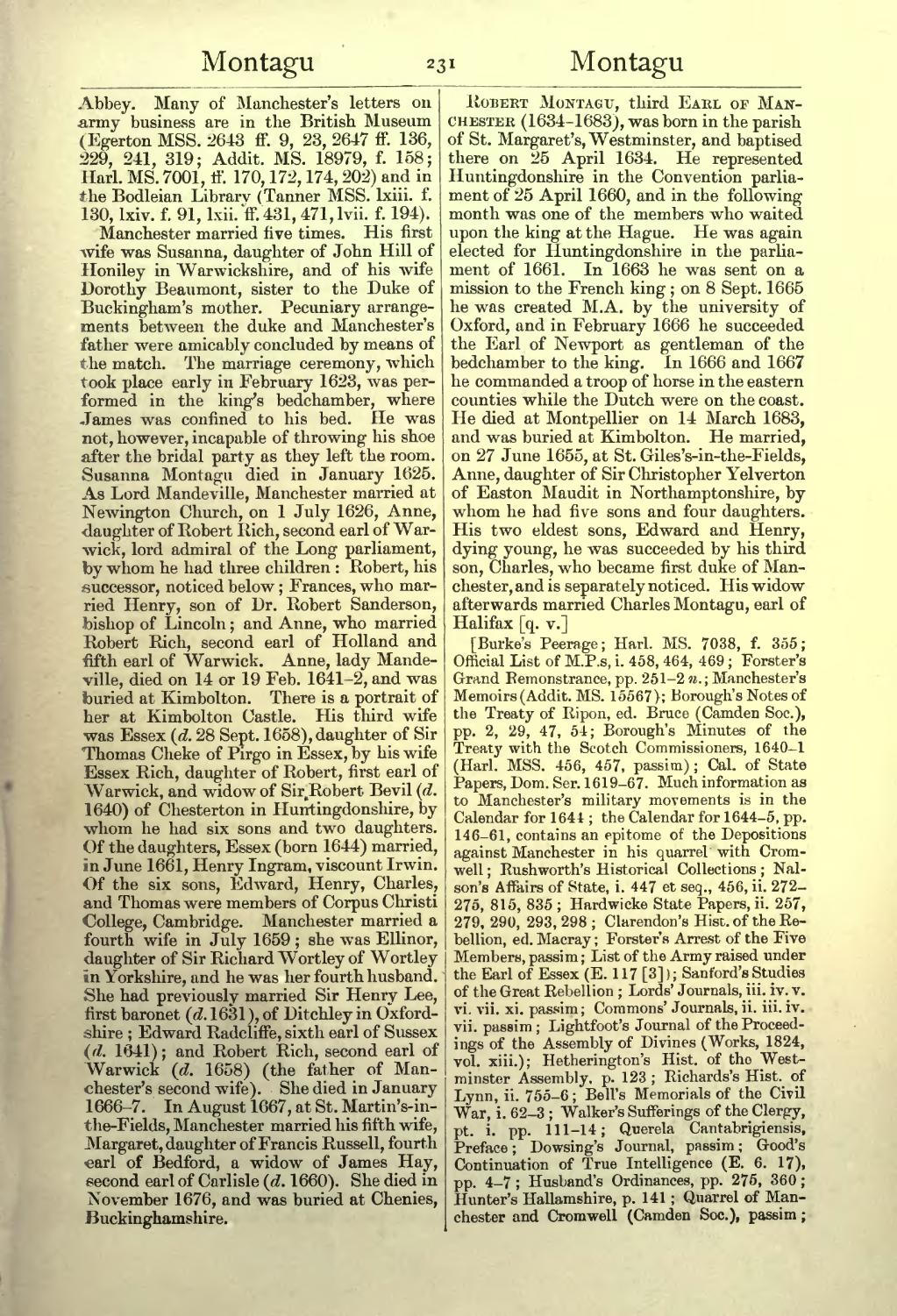Abbey. Many of Manchester's letters on army business are in the British Museum (Egerton MSS. 2643 ff. 9, 23, 2647 ff. 136, 229, 241, 319; Addit. MS. 18979, f. 158; Harl. MS. 7001, ff. 170, 172, 174, 202) and in the Bodleian Library (Tanner MSS. lxiii. f. 130, lxiv. f. 91, lxii. ff. 431, 471,lvii. f. 194).
Manchester married five times. His first wife was Susanna, daughter of John Hill of Honiley in Warwickshire, and of his wife Dorothy Beaumont, sister to the Duke of Buckingham's mother. Pecuniary arrangements between the duke and Manchester's father were amicably concluded by means of the match. The marriage ceremony, which took place early in February 1623, was performed in the king's bedchamber, where James was confined to his bed. He was not, however, incapable of throwing his shoe after the bridal party as they left the room. Susanna Montagu died in January 1625. As Lord Mandeville, Manchester married at Newington Church, on 1 July 1626, Anne, daughter of Robert Rich, second earl of Warwick, lord admiral of the Long parliament, by whom he had three children: Robert, his successor, noticed below; Frances, who married Henry, son of Dr. Robert Sanderson, bishop of Lincoln; and Anne, who married Robert Rich, second earl of Holland and fifth earl of Warwick. Anne, lady Mandeville, died on 14 or 19 Feb. 1641–2, and was buried at Kimbolton. There is a portrait of her at Kimbolton Castle. His third wife was Essex (d. 28 Sept. 1658), daughter of Sir Thomas Cheke of Pirgo in Essex, by his wife Essex Rich, daughter of Robert, first earl of Warwick, and widow of Sir,Robert Bevil (d. 1640) of Chesterton in Huntingdonshire, by whom he had six sons and two daughters. Of the daughters, Essex (born 1644) married, in June 1661, Henry Ingram, viscount Irwin. Of the six sons, Edward, Henry, Charles, and Thomas were members of Corpus Christi College, Cambridge. Manchester married a fourth wife in July 1659; she was Ellinor, daughter of Sir Richard Wortley of Wortley in Yorkshire, and he was her fourth husband. She had previously married Sir Henry Lee, first baronet (d. 1631), of Ditchley in Oxfordshire; Edward Radcliffe, sixth earl of Sussex (d. 1641); and Robert Rich, second earl of Warwick (d. 1658) (the father of Manchester's second wife). She died in January 1666–7. In August 1667, at St. Martin's-in-the-Fields, Manchester married his fifth wife, Margaret, daughter of Francis Russell, fourth earl of Bedford, a widow of James Hay, second earl of Carlisle (d. 1660). She died in November 1676, and was buried at Chenies, Buckinghamshire.
Robert Montagu, third Earl of Manchester (1634–1683), was born in the parish of St. Margaret's, Westminster, and baptised there on 25 April 1634. He represented Huntingdonshire in the Convention parliament of 25 April 1660, and in the following month was one of the members who waited upon the king at the Hague. He was again elected for Huntingdonshire in the parliament of 1661. In 1663 he was sent on a mission to the French king; on 8 Sept. 1665 he was created M.A. by the university of Oxford, and in February 1666 he succeeded the Earl of Newport as gentleman of the bedchamber to the king. In 1666 and 1667 he commanded a troop of horse in the eastern counties while the Dutch were on the coast. He died at Montpellier on 14 March 1683, and was buried at Kimbolton. He married, on 27 June 1655, at St. Giles's-in-the-Fields, Anne, daughter of Sir Christopher Yelverton of Easton Maudit in Northamptonshire, by whom he had five sons and four daughters. His two eldest sons, Edward and Henry, dying young, he was succeeded by his third son, Charles, who became first duke of Manchester, and is separately noticed. His widow afterwards married Charles Montagu, earl of Halifax [q. v.]
